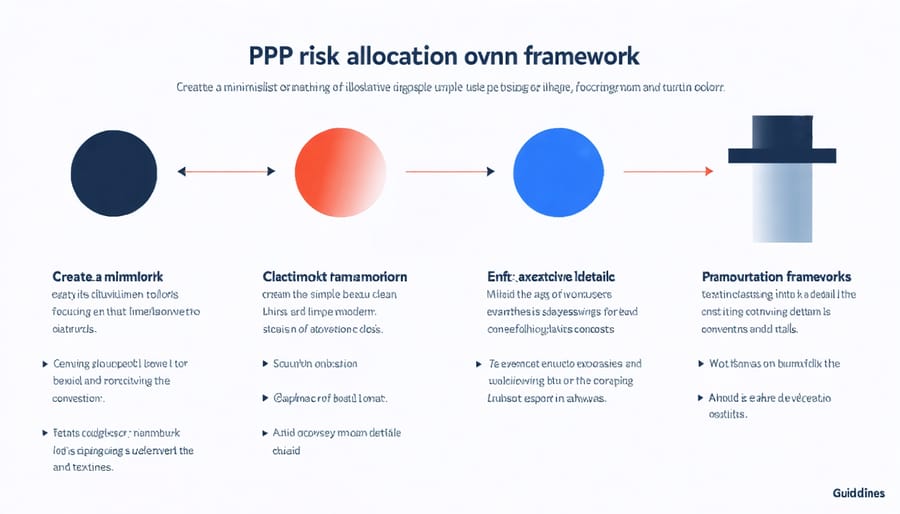Transformative public-private partnerships continue reshaping global infrastructure development, delivering exceptional value across transportation, healthcare, and urban development sectors. From London’s Crossrail project to Singapore’s Sports Hub, these strategic collaborations demonstrate how public sector oversight combined with private sector efficiency drives innovation and cost-effectiveness in major construction initiatives.
Recent analysis of successful PPP projects reveals a consistent pattern: partnerships that clearly define risk allocation, establish transparent governance frameworks, and maintain flexible adaptation mechanisms consistently outperform traditional procurement methods by 15-20% in both delivery time and budget adherence. The Hong Kong-Zhuhai-Macau Bridge exemplifies this approach, leveraging private sector expertise while maintaining public accountability throughout its complex construction phase.
For construction professionals and project stakeholders, understanding these benchmark examples provides crucial insights into structuring successful partnerships. Whether developing urban transit systems, healthcare facilities, or educational institutions, these cases offer practical frameworks for risk mitigation, stakeholder engagement, and long-term value creation in contemporary infrastructure development.
Transportation Infrastructure Success Stories
The Heathrow Terminal 5 Project
Heathrow Terminal 5 stands as a landmark achievement in public-private partnership, demonstrating how effective collaboration between public authorities and private enterprises can deliver complex infrastructure projects. The £4.3 billion project, completed in 2008, emerged from a strategic partnership between BAA (now Heathrow Airport Holdings) and a consortium of construction firms, including Laing O’Rourke and MACE.
The partnership structure incorporated innovative risk-sharing mechanisms, with BAA taking on the primary financial risk while construction partners contributed expertise and resources. This arrangement allowed for better cost control and efficient project delivery, despite the project’s massive scale and complexity.
Key success factors included the implementation of an integrated team approach, where BAA and construction partners shared office space and worked under unified project goals. The partnership utilized advanced construction methodologies, including off-site manufacturing and just-in-time delivery systems, which significantly reduced on-site congestion and improved efficiency.
The project introduced several groundbreaking initiatives, including:
– A dedicated Construction Consolidation Centre reducing vehicle movements by 60%
– Implementation of Building Information Modeling (BIM) before it became industry standard
– A comprehensive stakeholder engagement program ensuring smooth coordination between all parties
Despite initial operational challenges during opening, Terminal 5 has since become a benchmark for large-scale airport infrastructure development. The facility processes approximately 32 million passengers annually and has consistently ranked among the world’s best airport terminals for passenger experience.
The financial structure of the PPP demonstrated innovation, with clearly defined performance metrics and risk allocation. BAA’s investment was supported by long-term agreements with airlines, particularly British Airways, ensuring revenue stability and operational efficiency.
This partnership exemplifies how well-structured PPPs can deliver complex infrastructure while maintaining high standards of quality and innovation. The project’s legacy continues to influence modern airport construction and serves as a model for future large-scale infrastructure partnerships.

Dubai Metro Red Line Extension
The Dubai Metro Red Line Extension project represents one of the most significant applications of innovative financing approaches in modern transit infrastructure development. The 15-kilometer extension, connecting the existing Red Line to the Expo 2020 site, demonstrates how public-private partnerships can effectively deliver large-scale transportation projects.
The project’s financing structure combined government funding with private sector investment through a carefully structured agreement. The Roads and Transport Authority (RTA) of Dubai partnered with a consortium of international contractors and financiers, establishing a framework that distributed risks and responsibilities effectively between all parties. This arrangement enabled the mobilization of approximately AED 10.6 billion ($2.9 billion) in total project costs.
Key elements of the partnership included performance-based payments, long-term maintenance agreements, and shared revenue mechanisms. The private sector partners assumed responsibility for construction quality and timeline adherence, while the RTA maintained oversight of strategic decisions and operational standards. This arrangement incentivized efficiency and innovation while ensuring public interest protection.
Construction complexities were managed through advanced project delivery methods, including Building Information Modeling (BIM) and integrated project delivery systems. The consortium implemented value engineering solutions that reduced costs without compromising quality, demonstrating the private sector’s ability to bring technical expertise and operational efficiency to public infrastructure projects.
The success of this extension has become a benchmark for similar projects globally, particularly in rapidly growing urban centers. Notable outcomes include:
– Completion ahead of schedule despite technical challenges
– Integration of sustainable design elements
– Implementation of smart transportation technologies
– Successful risk management through the project lifecycle
– Enhanced connectivity for over 270,000 daily passengers
This project exemplifies how well-structured PPPs can deliver complex infrastructure while maintaining public service quality and financial sustainability.
Healthcare Facility Developments

Queen Elizabeth Hospital Birmingham
The Queen Elizabeth Hospital Birmingham (QEHB) stands as one of the most significant healthcare PPP projects in the United Kingdom, with a total investment value of £545 million. Completed in 2010, this state-of-the-art facility encompasses 1,213 beds, 30 operating theaters, and the largest critical care unit in Europe.
The partnership between University Hospitals Birmingham NHS Foundation Trust and Consort Healthcare (Birmingham) Ltd demonstrates the successful implementation of a Design, Build, Finance, and Operate (DBFO) model. The private consortium, led by Balfour Beatty and HICL Infrastructure Company, secured a 40-year concession agreement to deliver and maintain the facility.
Notable technical innovations include the hospital’s modular construction approach, which reduced build time by 18 months, and the integration of advanced medical technology infrastructure. The facility incorporates sustainable design elements, achieving a BREEAM “Excellent” rating through features such as natural ventilation systems and energy-efficient lighting.
The project’s financial structure combines public capital with private financing, with annual unitary payments from the NHS Trust to the private partner covering both capital and operational costs. Performance metrics are strictly monitored, with payment deductions linked to service delivery standards.
Key success factors include robust risk allocation, clear performance specifications, and strong stakeholder engagement throughout the development phase. The project has received multiple awards for its design excellence and operational efficiency, setting new standards for healthcare infrastructure delivery through PPP arrangements.
Despite initial challenges in transitioning services from the old facility, QEHB has maintained high patient satisfaction rates and operational performance indicators, validating the PPP model’s effectiveness in delivering complex healthcare infrastructure.
McGill University Health Centre
The McGill University Health Centre (MUHC) project stands as Canada’s largest public-private partnership in the healthcare sector, with a total investment of CAD 1.3 billion. Completed in 2015, this state-of-the-art facility in Montreal represents a groundbreaking collaboration between the Quebec government and the private sector consortium led by SNC-Lavalin.
The project encompassed the construction of a 346,150-square-meter super-hospital, consolidating five existing facilities into one modern healthcare complex. The PPP structure involved a 34-year concession agreement, including design, construction, financing, and facility maintenance responsibilities assigned to the private partner.
Key features of this PPP arrangement included performance-based payments, risk transfer mechanisms, and stringent quality standards. The private consortium assumed significant construction and operational risks while maintaining the building systems, leaving clinical services under public management. This separation of responsibilities allowed healthcare professionals to focus on patient care while ensuring optimal facility management.
Despite initial challenges, including construction delays and budget adjustments, the project delivered several notable innovations. These included advanced medical equipment integration, sustainable design features achieving LEED Silver certification, and sophisticated building management systems. The facility now serves over 700,000 patients annually and houses cutting-edge research facilities.
The MUHC project demonstrates how PPPs can effectively deliver complex healthcare infrastructure while maintaining public control over essential services. Its success has influenced subsequent healthcare PPP projects across North America, establishing benchmarks for risk allocation, performance monitoring, and stakeholder engagement in large-scale medical facility development.
Educational Infrastructure Innovation
Victorian Schools Project
The Victorian Schools Project stands as one of Australia’s most ambitious public-private partnership initiatives in the education sector, encompassing the design, construction, and maintenance of 11 new schools in Melbourne’s growing suburbs. Launched in 2008 with a total investment of AUD 255 million, this comprehensive program demonstrated the effective collaboration between the Victorian government and private sector consortia.
The project’s scope included delivering modern educational facilities for approximately 8,500 students, with each school featuring state-of-the-art learning spaces, multimedia centers, and specialized facilities for science, arts, and physical education. The private sector partner, Axiom Education Victoria, took responsibility for the 25-year lifecycle management of these facilities, ensuring their ongoing maintenance and operational efficiency.
Key innovative features of this PPP model included the implementation of sustainability measures across all facilities, resulting in a 30% reduction in energy consumption compared to traditional school buildings. The project incorporated solar panels, rainwater harvesting systems, and energy-efficient lighting, setting new benchmarks for sustainable school design in Australia.
The payment mechanism was structured around availability and performance criteria, with the private partner receiving quarterly service payments contingent upon meeting predetermined facility management standards. This arrangement effectively transferred operational risk to the private sector while ensuring consistent service delivery.
Project outcomes have been notably positive, with all schools delivered on schedule and within budget. Independent assessments have shown improved learning environments, reduced operational costs, and high satisfaction rates among educators and students. The facilities have maintained excellent condition through the ongoing maintenance program, demonstrating the effectiveness of the lifecycle approach inherent in PPP projects.
The Victorian Schools Project has become a reference point for similar educational infrastructure initiatives worldwide, particularly in terms of risk allocation, performance monitoring, and sustainable design integration. Its success has led to the adoption of comparable models in other Australian states and territories, validating the PPP approach for large-scale educational infrastructure development.
The project’s achievement in balancing public sector educational requirements with private sector efficiency has made it a compelling case study for construction professionals and policy makers considering PPP arrangements for social infrastructure projects.

Critical Success Factors

Risk Allocation Strategies
Effective risk allocation is fundamental to successful PPP projects, requiring a balanced approach that assigns risks to the parties best equipped to manage them. The optimal strategy typically involves the public sector assuming regulatory and political risks while private partners handle construction, operational, and market-related challenges.
Key risk allocation principles include transferring design and construction risks to private contractors who possess the technical expertise and experience to mitigate these challenges effectively. Financial risks are often shared, with government entities providing certain guarantees while private partners secure project financing and manage revenue risks.
Environmental and force majeure risks generally require a collaborative approach, with both parties sharing responsibilities and establishing clear protocols for risk management. Modern PPP agreements increasingly incorporate specific provisions for climate-related risks and sustainability requirements, reflecting growing environmental concerns.
Performance risks are typically allocated to private partners through output-based specifications and performance indicators, while demand risks may be shared or transferred depending on project characteristics. Successful risk allocation strategies often employ risk matrices and detailed contingency plans, supported by robust monitoring and reporting mechanisms.
Insurance requirements play a crucial role, with private partners usually responsible for maintaining comprehensive coverage for construction and operational risks. The public sector may step in to provide coverage for extraordinary events or risks that the commercial insurance market cannot adequately address.
Recent innovations in risk allocation include the use of hybrid models that allow for more flexible risk-sharing arrangements and the incorporation of digital tools for real-time risk monitoring and management.
Stakeholder Management
Effective stakeholder management is crucial for the success of public-private partnerships, requiring a strategic approach to balance diverse interests and expectations. Successful PPP projects demonstrate consistent patterns in stakeholder engagement, emphasizing early involvement, transparent communication, and systematic risk allocation.
Key stakeholders typically include government entities, private sector partners, financial institutions, local communities, and end-users. Industry leaders recommend establishing a dedicated stakeholder management team during the project’s initiation phase, responsible for developing and implementing comprehensive engagement strategies.
Research shows that PPP projects with robust stakeholder management frameworks achieve 23% higher satisfaction rates and experience fewer delays. For instance, the Denver International Airport’s Great Hall Project implemented a multi-tier communication strategy, engaging with airlines, retail concessionaires, and passenger groups through regular workshops and feedback sessions.
Best practices include:
– Regular stakeholder mapping and analysis
– Clear communication channels and reporting structures
– Formal dispute resolution mechanisms
– Community engagement programs
– Transparent decision-making processes
– Regular progress updates and milestone celebrations
Effective stakeholder management also involves proactive risk mitigation. Successful PPPs employ sophisticated risk allocation matrices, ensuring each risk is assigned to the party best equipped to manage it. This approach has proven particularly effective in complex infrastructure projects where multiple stakeholders share overlapping responsibilities.
Documentation and tracking of stakeholder interactions through digital platforms have become increasingly important, enabling real-time monitoring of engagement effectiveness and quick response to emerging issues. Regular stakeholder satisfaction surveys and performance metrics help maintain accountability and drive continuous improvement throughout the project lifecycle.
Public-private partnerships have proven to be transformative in delivering complex construction projects across the globe. As we’ve explored through various examples, successful PPPs consistently demonstrate the power of combining public sector oversight with private sector efficiency and innovation. The key learnings from these partnerships highlight the importance of clear risk allocation, transparent communication, and robust contractual frameworks.
Looking ahead, the future outlook for construction PPPs appears increasingly promising, particularly as governments worldwide seek sustainable solutions for infrastructure development. The integration of digital technologies, sustainable building practices, and innovative financing mechanisms will likely reshape how these partnerships operate.
Several critical factors will continue to drive PPP success in construction:
– Enhanced stakeholder engagement and community consultation
– Implementation of standardized best practices and frameworks
– Adoption of advanced project management tools and methodologies
– Focus on environmental sustainability and social impact
– Greater emphasis on long-term maintenance and lifecycle costs
As the construction industry evolves, PPPs will need to adapt to address emerging challenges such as climate resilience, urbanization, and changing demographic needs. The lessons learned from current successful partnerships will serve as valuable guidelines for future projects, ensuring more efficient resource allocation and improved project outcomes.
The future of PPPs in construction lies in creating more flexible, innovative, and sustainable partnerships that can effectively respond to complex infrastructure challenges while delivering value for both public and private stakeholders.

